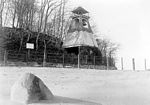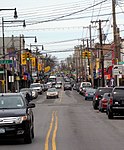Bronx–Whitestone Bridge

The Bronx–Whitestone Bridge (colloquially referred to as the Whitestone Bridge or simply the Whitestone) is a suspension bridge in New York City, carrying six lanes of Interstate 678 over the East River. The bridge connects Throggs Neck and Ferry Point Park in the Bronx, on the East River's northern shore, with the Whitestone neighborhood of Queens on the southern shore. Although the Bronx–Whitestone Bridge's construction was proposed as early as 1905, it was not approved until 1936. The bridge was designed by Swiss-American architect Othmar Ammann and design engineer Allston Dana and opened to traffic with four lanes on April 29, 1939. The bridge's design was similar to that of the Tacoma Narrows Bridge, which collapsed in 1940. As a result, extra stiffening trusses were added to the Bronx–Whitestone Bridge in the early 1940s, and it was widened to six lanes during the same project. The Bronx–Whitestone Bridge was also renovated in 1988–1991 to repair the anchorages, roadways, and drainage. The stiffening trusses were removed during a renovation in the mid-2000s, and the bridge's deck and approach viaducts were replaced soon afterward. The Bronx–Whitestone Bridge is owned by New York City and operated by MTA Bridges and Tunnels, an affiliate agency of the Metropolitan Transportation Authority. With a center span of 2,300 feet (700 m), the Bronx–Whitestone Bridge once had the fourth-largest center span of any suspension bridge in the world. The bridge has a total length of 3,700 feet (1,100 m), and its towers reach 377 feet (115 m) above water level.
Excerpt from the Wikipedia article Bronx–Whitestone Bridge (License: CC BY-SA 3.0, Authors, Images).Bronx–Whitestone Bridge
Malba Drive, New York Queens
Geographical coordinates (GPS) Address External links Nearby Places Show on map
Geographical coordinates (GPS)
| Latitude | Longitude |
|---|---|
| N 40.801111111111 ° | E -73.829166666667 ° |
Address
Bronx-Whitestone Bridge
Malba Drive
11357 New York, Queens
New York, United States
Open on Google Maps







